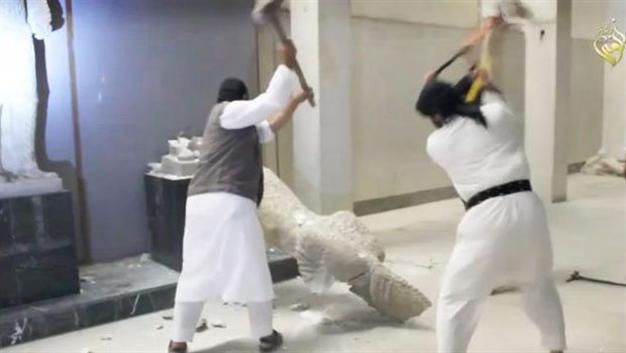ISIL destroy ancient artefacts in Iraq
BAGHDAD - Agence France-Presse

Islamic State of Iraq and the Levant (ISIL) militants armed with sledgehammers and jackhammers have destroyed priceless ancient artefacts in Iraq's city of Mosul, a video released by the jihadists on Feb. 26 shows.
The destruction sparked widespread consternation and alarm, with some archaeologists and heritage experts comparing it to the 2001 demolition of the Bamiyan Buddhas in Afghanistan by the Taliban.
The United Nations' cultural agency immediately demanded an emergency meeting of the Security Council, arguing that heritage protection was an integral part of Iraq's security.
The video shows ISIL militants knocking statues off their plinths and rampaging through the Mosul museum's collection, which includes artefacts from the Assyrian and Hellenistic periods dating back to several centuries before Christ.
It also shows jihadists using a jackhammer to deface an imposing granite Assyrian winged bull at the Nergal Gate in Mosul.
"Muslims, these artefacts behind me are idols for people from ancient times who worshipped them instead of God," said a bearded militant speaking to the camera.
"The so-called Assyrians, Akkadians and other peoples had gods for the rain, for farming, for war... and they tried to get closer to them with offerings," he goes on.
"The prophet removed and buried the idols in Mecca with his blessed hands," he said, referring to the Muslim prophet Mohammed.
Experts said the items destroyed include original pieces, reconstructed fragments and copies.
Thomas Campbell, the director of New York's famed Metropolitan Museum of Art condemned the "act of catastrophic destruction to one of the most important museums in the Middle East."
"This mindless attack on great art, on history, and on human understanding constitutes a tragic assault not only on the Mosul Museum, but on our universal commitment to use art to unite people and promote human understanding," he said in a statement.
The artefacts destroyed are from the Assyrian era and from the ancient city of Hatra, which lies in the desert about 100 kilometres (60 miles) southwest of Mosul.
The fate of the museum's Islamic collection remains unclear.
"This is kind of their Bamiyan moment," said Charles E Jones, a Pennsylvania University librarian and scholar who has worked for years to protect Iraqi heritage.
On Thursday, ISIL fighters also blew up the 12th century Khudr mosque in central Mosul, witnesses and academics said.
Ihsan Fethi, an Iraqi professor of architecture based in Amman, described it as "a terrible loss and an unbelievable act of cultural terrorism."
He said the jihadists blew it up because the mosque also housed a tomb, something ISIL considers as amounting to idolatry.
UNESCO director general Irina Bokova said she had demanded an emergency meeting of the Security Council following the destruction in Mosul.
"This attack is far more than a cultural tragedy - this is also a security issue as it fuels sectarianism, violent extremism and conflict in Iraq," she said in a statement.
The jihadists have controlled Mosul, Iraq's second city, since seizing it in a June offensive that saw them conquer large parts of the country.
They have systematically destroyed heritage sites, including several Sunni Muslim shrines.
The Mosul region was home to a mosaic of minorities, including the Assyrian Christians, who consider themselves to be the region's indigenous people.
Several Assyrian villages were seized by ISIL fighters in neighbouring Syria in recent days and at least 220 people kidnapped.
Bokova said the Mosul destruction was a violation of UN Security Council's resolution 2199.
The resolution was adopted earlier this month in a bid to curb trafficking of looted antiquities from Iraq and Syria, which is considered a key source of funding for the ISIL.
Referring to the destroyed artefacts in the Mosul museum, the man appearing in the video released on Thursday says: "Even if they are worth billions of dollars, we don't care."
But in his Conflict Antiquities blog, Dr Samuel Hardy, an archaeologist and criminologist, argues that the jihadists are only destroying the bulky pieces that cannot be smuggled out of the country.
"All this video really shows is that they are willing to destroy things that they can't ship out and sell off," he wrote.
 Islamic State of Iraq and the Levant (ISIL) militants armed with sledgehammers and jackhammers have destroyed priceless ancient artefacts in Iraq's city of Mosul, a video released by the jihadists on Feb. 26 shows.
Islamic State of Iraq and the Levant (ISIL) militants armed with sledgehammers and jackhammers have destroyed priceless ancient artefacts in Iraq's city of Mosul, a video released by the jihadists on Feb. 26 shows.